פרק קודם תוכן
7 Chapter
When people get up from their bed, they imagine that they dispelled their sleep, and do not know that they has become victim of their feelings, fall prey to a new dream, deeper, than what they have just left.
Gustav Meyrink
Before to continue consideration of further stages of Raja Yoga, we define how the inhibition of consciousness, representing the initial stage of chitta vritti nirodho (CVN),arises and develops in asanas.
Certainly, practice begins in the condition of wakefulness, but then the mental activity gradually becomes simpler and dies almost away: «… In this yoga one should practice resolutely, with an idea abhorred from everything» ("Bhagavad Gita", VI, 23). As in the given chapter the theme of the CСС(the changed condition of consciousness) will constantly come to light, we consider at first the technics of a deep relaxation created by Swami Satyananda Saraswati.
Yoga distinguishes four base updating of consciousness:
– Wakefulness (jagratam);
– Sleep with dreams (swapna);
– Sleep without dreams (sushupti);
– The "fourth" condition (outside the three previous) is turiya.
(« … Five kinds of activity are … true knowledge, fallacy, mental designing, sleep, and memory», later these five components have been reduced to the listed above four», 99, I, 5, p. 89).
1). Wakefulness
Its basic characteristics – according to data of EEG (electroencephalogram) – is "beta rhythm" with frequency of 14-30 hertz (by contact of attention with surroundings), and also by:
– Moving in horizontal and vertical planes and interaction (contact) with objects of the external world (consciousness is filled with "material" which is situated outside of the body);
– Similar moving, but without direct contact: sports, dances, walks (consciousness is outside of the body);
-Temporary elimination of physical activity: reception of information, deliberation, rest, contemplation of nature, listening to music, etc. (consciousness is outside of the body);
– Processes connected with satisfaction ofphysical needs (consciousness is in part or completely concentrated on the body);
– Circus trainings and performances (consciousness supervises the body moving in space);
– Shamanism, ritual dances, wu shu, spinning dervishes, etc. (the body movement occurs without interaction with the external world, consciousness is deprived the habitual orientation, activity, and it is inverted inside);
– The full absence of movement, consciousness is either entirely concentrated on the body and its specific activity (Hatha Yoga) or is outside of the body, but is switched off from the surrounding – Raja Yoga (the body movement is allowable at the partialinhibition of consciousness – vipassana, lun–gom–pa).
Not so long ago a new steady frequency 35 – 37 hertz has been found, it proceeds from the brain’s areas responsible for conscious attention, and it possesses mysterious properties of nonlocality.
2). Sleep
«In order to couch a dream as a grain, having deviated from the elected theme, we shall prepare wine from dry petals of chrysanthemum» (S. Kekova).
It is a special physiological state of organism which is accompanied by amaurosis fugax and the relative immovability of the body. Locomotor activity is conditioned only by needs of blood circulation and "leak" of some part of nervous pulses into motor structures.
Till now the science did not develop the common opinion concerning the nature of sleep and its functions. There are some data that the sleep without dreams restores the tissue exchange and anabolic processes, and also removes information overloads. In 1974, Arshavskyand Rotenbergoffered hypothesis of the compensation nature of fast dream – at this time the brain plays scripts which one did not manage to realize in life.
K.G. Jung considered sleep as one of the channels of intrapsychic communications, through which the system mind shows the person his problems in a symbolical form. If to accept such point of view – and it is confirmed by facts – then it follows from this that:
– At the switched off consciousness psyche acquires and distributes information, perceived during wakefulness, in different kinds of memory; the superseded makes active some independent psycho-complexes; subconsciousness in a symbolical form "shows" some important points of ego memory, etc.;
– If during the sleep the ordering of the information perceived from the outside occurs successfully, the person preserves adaptation to surrounding.
Apparently, theemotional comfort is consequence of information "parity" between consciousness and the unconscious; on the part of physiology this is a dynamic balance of the tone of two basic parts of ANS.
«In the stage of deep dream, in activity … of the brain it is found deterministic chaos with a fractal attractor in five-measured space (characterized by five independent variables – V. B.)» («Order from Chaos», p. 89). It is significant if to recollect that the brain’s communications with the world is carried out by means of eyesight, hearing, sense of smell, touch, and taste. Apparently, in its sleep the brain "shuffles" this five-measured "solitaire", transforming the perceived in its interests. There are no accidents here as in cerebral space the own rigid laws operate.
2. Sleep with dreams
Phase of «fast dream». If the person is awaken in it, almost always he tells about his dream. Fast sleep or REM(from «rapid eye movements» is a distinctive attribute of this phase) is characteristic by prevalence in encephalogram (EEG) of theta rhythm with frequency from three to seven hertz. All time of the night sleep consists approximately of four-five cycles; each begins with a "slow" phase and comes to the end with the "fast". In the sum REM phasemakes up not less than two hours. People, asserting that they do not see dreams, simply do not wake up in this stage which is characteristic by the activity of a so-called «locus coeruleus», providing the physical immovability.
3. Sleep without dreams is called the "slow" one; it is subdivided into a number of stages. The last two are a deep "delta-dream", with frequency of EEGfrom 0,5 to two hertz. The nightmares arise more often in this stage. There is a hypothesis that dreams are a safety valve for discharge of the suppressed instincts and promptings. «The touch of the One God, being declared in east doctrines and connected with the sleep without dreams, makes up – a hard-to-solve … riddle. And synergetic models allow slightly to open the veil above this secret. According to synergetic understanding, the HS-mode of cooling corresponds to the sleep without dreams, – a mode of infinite spreading from the center, a mode of the endless scattering wave. In this mode processes progress so as they will progress in the whole structure in the absolute future (at the time aspiring to infinity). Being in this condition, the person … is identified with a condition of the absolute future of the universal organization. There is some harmonization, verification of available processes with the aim, with the future order» ("Foundations of Synergetics", p. 103).
4. Turiya (superconsciousness) is reached in samyama, and also by means of one of the versions of the deep relaxation – yoga of psychical sleep (Yoga Nidra).
«The one who had reached Yoga Nidra is incomprehensible for death» ("Gheranda Samhita", 4, 48). SSS created this technics of the deep relaxation on the basis of Nyasa, described in "Mahanirvana Tantra", having abolished a number of ritual elements. It is not ruled out that he had used some elements of European technics ofSchultz and Cue, fractional hypnosis and hypnosuggestion with addition of the Indian colour like chakras, lingamsand the other exotic easily realized in the changed condition of conscious (CCC). Sometimes one names Nidra the dynamic sleep or method of self-guidance of dreams.
In the overwhelming mass of population, inhabitants of the "gold billion" countries do not have a deep relaxation (especially mental!)in control; and the usual sleep does not provide a full relief of stress accumulated during wakefulness. Yoga Nidraare dotted losses of consciousness which are not sleep! During them the general overstrain, and subsequently also the superseded pathological material spontaneously leave psychosomatics.
Events in the heterogeneous autotraining proceed similarly, but the attention to the process itself is not fixed there. It is not clear exactly, how the saved overloads and superseded "material" "evaporate". Most likely, in phase transitions there is a diffusion of mental deformations from subconsciousness into consciousness, devastated by the mental relaxation. Each such emission is accompanied by the activation of a picture of a muscular tension accompanying it. Then consciousness "is switched-on" and, following the voice of the presenter, continues the movement on the body, weakens muscles to the end, "erasing" again the showed through contracture. Thus, engrams lose the anchor. The similar technics is applied in behavioural therapy, in neuro-linguistic programming (NLP), and in АТ- sensitizing therapy – with that only difference that here the theme of work is defined by the patient himself or the doctor, but in Nidra the choice occurs spontaneously, psychosomatics carries it out without participation of the subject.
Nidra is a fluctuation of the tone of consciousness between the levels of activity of CNS adequate to sleep and wakefulness; in this process the subject stays from 20 till 45 minutes. A monotonous moving of attention on the body results to that consciousness sometimes dies away, "being rolled itself up" to the borderline where «you cease to be» (full disappearance of the control), sometimes appears. « … One can fix the communications with the subconscious much easier than in case if both parts of the person use one means – speech» («Strategy of Psychotherapy», p. 252).
In process of falling asleep, activity of cells of cerebral cortex passes certain phase conditions discovered as far back as by I.P. Pavlov:
1. Awake consciousness: the tone is in norm, excitation is proportional to inhibition;
2. Equalizing phase: weak and strong stimuli cause identical reactions;
3. Paradoxical or transitive phase: weak stimulicause a strong reaction and vice versa, or there is no reaction at all to the strong ones;
4. Ultraparadoxical phase: positive stimuli do not cause reaction at all, and the negative give a positive reaction;
5. Narcotic phase: equally weak reaction to all stimuli;
6. Full inhibition: deep sleep.
Repeatedly and rhythmically, "crossing" in various sequence the whole spectrum of these phase conditions by attitude on the safety of consciousness («I do not sleep, I am awake and I listen to practice of Yoga – Nidra…), the subject stays some time «in vicinities» of the paradoxical phase. It enables an earlier established intention, on the one hand, – to penetrate into the unconscious, to take roots there, and to become a constant generator of unconscious actions. On the other hand, the sensibleness is kept at the actual disconnection of consciousness. «…Any thought which you keep in mind at the condition of internal silence, is equivalent to a command as there are no other thoughts there, capable to compete with it» («Fairytales about Force», books I – IV, p. 454).
Nidra can (with extreme care!) be used for self-programming, the given process is NOT described here, as it is dangerous and demands wide experience.
Experiences with participation of Swami Rama (fund of Menninger, Kansas, 1977) had showed that awake consciousness can be kept in transitive stages of inhibition. According to character of EEGit was visible, that the yogin was in the state of a deep sleep, but at the same time he perceived the questions turned towards him, and detected the basic events of ambient. Being mastered, Nidra allows coming into the fourth state – superconsciousness. Nidra masteringenables to operate dreams. Ability of "ego" to observe own dreams is a dynamic form of Pratyahara.
Yoga Nidra restores the broken functional communications between the left forward side and right back side of the brain, and also removes the overexcitation of the left back and right forward parts of them, which forms depression.
Generally speaking, all meditative technics lead anyhow to «the fourth condition», it is only necessary that they answered to the mental make-up of the concrete person.
The sign of a really meditative condition is prevalence ofactivity of alpha – rhythm in EEG, some time it is kept even at open eyes what does not happen in usual wakefulness.
Let's return to the theme of the chapter. So, asana. This technical term almost simultaneously appears in "Shvetashvatara" and "Kshurika" Upanishadas, "Bhagavad Gita" and "Buddha Charite" (Ashvaghosha, I century A.D.). Apparently, the physical aspect of yoga has a rather ancient origin as the Vedas mention asanas vaguely. However concepts "asana" и "pranayama" have been assimilated by the Aryan culture not at once, what was reflected in later works, for example, in "Trishikhabrahmana Upanishad" where poses are discussed in sufficient detail.
Leaning on dark places of primary sources and different interpretations of commentators, falsifiers of yoga declare today: «The Book tradition of Patanjaliwhich has arisen, according to some estimation, in 150 B.C., is dead. It is considered that Vjasa, the first commentator of Patanjali, already had not links with tradition – if such one had existed at all» («Dynamic Practices in Classical Yoga», p. 80).
World famous scientists Dasguptaand Shcherbatskoy did not practice themselves, but, possessing enormous volume of information, they did not doubt for some reason about continuity of the yogictradition!
Nevertheless, Sjoman asserts that the history of yoga «… Is based … on separate texts, and it does not have a united basic idea» (ibid, p. 84).
«Just that very body is a tool with which help the spiritual purposes are reached. The whole Hatha Yoga consists in it. The Naths unshakably stand for that Hatha Yoga is a spiritual discipline. But today's point of view differs very much… » (ibid, p. 93).
What is the fashionable Ashtanga Vinyasa Yoga, widespread in the world by pupils and followers of guru Krishnamacharya, and in what its difference from the traditional Ashtanga Yoga consists– in other words Raja Yoga?
There is not a word about Vinyasa by Patanjali and his commentators. In late (medieval) Tantric texts, such as "Hatha Yoga Pradipika" (where fifteen asanas are enumerated) and "Gheranda Samhita" (thirty two asanas), no traces of Vinyasas are found too!
What does the primary source say, that is Yoga Sutras? Let us see translations of some authors.
46. Asana is a motionless and convenient pose.
46. Asana [should be] steady and convenient (P. Gradinarov);
46. As a result of asanas practice,stopping efforts and concentration on the infinite is reached (R. Mishra);
46. Asana should allow to keep attention and to keep slackness (T. Deshikachar);
46. Position of the body is that what is firm and pleasant (Vivekananda);
46. Asanas are poses combining in themselves stability and convenience (A. Falkov);
46. Asana, pose, should be steady and convenient (C. Svensson);
46. The word "asana" is used for [designation] of a pose for meditation. Asana does not designate here physical exercises of yoga. Basically the word asana is used for designation of yoga exercises, but here [in the given comment of SSS on Sutra 46 of the second chapter – V. B.] it designates only any pose which is intended for meditation. For example, Svastikaasana, Siddhasanа, Padmasana, Sthipasanа, and Sukhasanа. These are asanas, i.e. [the poses], intended for meditation. Nevertheless, there are noobstacles to name asanas also other poses. Other exercises, such as Sirshasanа, etc., had been included by Rishas in number of asanas much later. It does not mean that they are not obligatory only because they are not included in Sutras of Patanjali» («Yoga Sutra of Patanjali», Minsk, p. 215).
47. At thestopping effort /asana/ is reached… Perfection of asana is reached at full removal of tension due to what all movements of the body stop– so speaks Vyasa in his "Bhashya" («Classical Yoga», p. 143).
47. [It is comprehended] by means of relaxation of efforts and meditation on the infinite (P. Gradinarov);
47 («Heart of Yoga», p. 210 – actuallythe Sutra is not translated);
47. By easy effort and reflections on the boundless, position of the body becomes firm and pleasant (Vivekananda);
47. At an easy effort and reflection on the infinite … (A. Falkov);
47. It is reached by easing of efforts and reflection on the boundless (C. Svensson);
«The body should be accustomed without inconvenience and pains to remain in the motionless conditionduring long time» («Nada Bindu Upanishad», 3, 3, 1).
«A correct pose is completely necessary for clearance of the body and achievement of success in yoga» ("Rudra Yamala Tantra", part 2, 24-38, 39).
«It is important that asanas make the body steadily motionless, and at the same time reduce physical efforts to a minimum» («Immortality and Freedom», p. 116).
«… It is an asana, the general name of widely known yogicposes which is defined in Yoga Sutras as «sthira sukham», i.e. «motionless and convenient» (ibid).
«At level of the physical body, asana is an ekagrata, concentration on one point; the body "is compressed", concentrated in the dot position. Just as ekagratabrings an end to fluctuations… and so asana reducing an infinite variety of possible positions of the body to one archetypical … pose, stops corporal mobility and instability» (ibid, p. 118).
So, defining the essence of concept "asana", neither classical texts of yoga nor the Tantra mentionany special or additional movements except for which are necessary for an entry in the pose and exit from it! These necessary movements are meant by themselves, but they have extremely minor, serving character and are never a subject to discussion! The model of the event called asana is a triad: an entry into the form (asana), its fixing (keeping in the immovability), and return in the starting position. To the three listed components one added the fourth – Vinyasa what had radically changed the sense of practice! From sequence of long static poses alternated with the exit from one and entry in another (these movements are also slow and static!), it turned to an infinite movement. Vinyasas (so-called "liaisons") are elements of Surya Namaskar, carried repeatedly out and at a sufficiently quick rate. In such practice it is impossible to receive chitta vritti nirodho (CVN)! But then there is a question: If Ashtanga Vinyasa is not aimed to achieve CVN, then what gives it?
A dynamic series of positions called Surya Namaskar(SN) is known from the extreme antiquity; different schools speak about it rather respectfully, including SSS. It obviously has fighter’s sources; initially schools of struggle and yoga were under patronage of the same monastic orders, quite often in one room and with the same teacher.
Fragments of SN,named Vinyasas, had been included by Krishnamacharya in his personal practice as know-how. Andto this day such practice is presented in this way by his apologists to pupilsasyoga.
Vinyasas (or something rather similar to them) are described also in the Tibetan systems of Yantra Yogaand khor lowhich are, probably, generated by climatic features of highland. Krishnamacharya asserted that he had studied Vinyasa and Pranayama in Tibet, by R. Brahmachari.
According to Sjoman, Vinyasas were used in rituals of Vedasfor giving maximal efficiency to mantras: «Vinyasas are namedmovements in intervals between asanas» («Dynamic Practices in Classical Yoga», p. 97).
So, series of additional movements unknown to Patanjaliand his ancient commentators are widely applied in «author's styles of dynamic yoga» except minimal stay in the poses (3 – 5 seconds), similar externally to asanas.
Till the XIX century the history of yoga did not know precedent when completely "unauthorized" dynamic inserts had been announced the central part of practice apart from asanas! SN, which fragments Krishnamacharya made to the basis of his methods, is mentioned neither by Sutras nor commentators; and Sjomanconfirms it. «… It is logical to suppose that the form of asanas sequencewhich we find by Pattabhi Joyce had been developed during Krishnamacharya’steaching. Itwas not traditional» (" Dynamic Practices in Classical Yoga", p. 100). It would be good if it were only one sequence; for some reason Sjoman does not notice the absolute heterogeneity of Vinyasas! Here is his note in the book «Dynamic Practices in Classical Yoga», footnote №69: « … The bibliography is cited here as it shows what sources wereconsidered by Krishnamacharya as authoritative, and it opens his attitude to traditions. It is a padded… bibliography in which there are books what have nothing in common with the tradition which he had taught. He included in his work ("Yoga Makaranda") material on yogic practices from these … sources, not being known with the true tradition… As an example it is possible to cite … recommendations on performance of Vajroli Mudra, where he calls to enter into urethra a glass tube one inch deep for one time. Such instructions testify that he almost for certain did not try it himself» ("Dynamic Practices in Classical Yoga", p. 121-122).
But if it is not a tradition what then pupils and followers of Krishnamacharya did «apprehended, developed, and improved» and distribute today worldwide? What from original yoga comprises Ashtanga Vinyasa Yoga except its name? Is it harmful, useful, or indifferent to soul and the body? Has it got in the least bit a convincing philosophical substantiation? All these questions remain open.
B.L. Smirnov notes: «Sometimes one attributes to asanas also some dynamic sports techniques» (for example – Surya and Chandra Namaskara- V. B.), but « In essence every true yogic exercise aspires to suppress display of Guna Rajas(activity) and that is why it should be a static, instead of the dynamical one» («The Book about Bhishma», p. 201).
And further: «The ancient yoga understands under "asanas" special positions of the body kept more or less long time. Asanas are divided into two groups: the sports and meditative. The purpose of "sports" asanas is to strengthen the body, to make it hardier, to strengthen those or other currents of action which are called in Sanskrit as "Pranas". The purpose of meditative asanas is to create a steady position of the body which does not prevent the self-deepening, provides a correct blood supply of internal organs and a correct breathing. For both groups at performance of the given asana, preservation of the full immovability is considered as obligatory. This requirement is dictated by necessity of calming Gunas, without which… it is impossible to reach the purpose of yoga – steadiness».
Andre van Lysebeth, the founder and director of Institute of Integrated Yoga in Brussels, asserts: «Despite of great number, asanas are based on a limited quantity of principles: immovability, control of breathing (I understand here the word "control" as deliberate preservation of full naturalness and ease of the respiratory process without dependence on the form – V. B.), absence of efforts, stretching of muscles, and intellectual concentration. Ignoring or not understanding any of these factors, we lower the efficiency of poses».
«Asanas is only a system of complex positions of the body which at first sight seem to be fakiric, however at exact performance are not anything similar, as they cause neither pains nor any violence to the body. They are based on Arendt-Schultz's law: «Weak irritations stirs up vital forces, big irritations inhibit them, and the strongest destroy». Secondly, influence of asanas is based on the principle of circulation, discovered by August Bier: «Any position of the body has a purpose to cause a rush to the desirable organ or a part of the body». Thirdly, the question is a principle of doctor Ganeman, according to which (in connection with first two laws) «a wedge knocks out a wedge» – by means of enlivening dosages of an irritation» (B. Sakharov «Yoga from Primary Sources», network translation).
So, Ashtanga Vinyasa Yoga is a product of a voluntaristic crossing of the usual Hatha Yoga with Surya(and, probably, Chandra) Namaskara; monotonous reiterations of their fragments ("liaisons") make up the lion's share of the given practice, where asanas are actually only brief (in order not to say casual and minor) episodes.
The today's situation with yoga in Russia can be characterized by Vladimir Levi's words: «Since I had written my books, clever people became cleverer, the silly ones sillier, and millions other did not change in anything».
Let's address to one of the main postulates of Sutras: «… Or by concentration of [consciousness] on the infinite … asana is reached» («Classical Yoga», p. 143).
How can one weaken muscles? Certainly, by a mental command after what there are the physical attributes confirming its performance. The first stage of muscular relaxation is a specific mental effort which is accompanied by an appreciable (sometimes) consumption of neuropsychic energy. In everyday life the person uses only some standard (archetypical, the least energy cost-based) positions of the body and their variants (he sits, lies, stands, goes).
As a rule, the beginner who had on his own started mastering asana, will try to perform them «as in a picture», in fact no sweet without sweat. In this case diligence is a habit; now it is high time to return to the beginning of the chapter and to read carefully the epigraph through. Any unfamiliar activity including a physical, generates effort of the body and mind (thinking midstream how it is better to realize this activity), consequently there are muscular, mental, and psychological components of the given activity. Though the purpose of practice declared initially is a distraction of mind from daily cares and thoughts, the beginner honestly tries to bend in order to repeat the picture probably most precisely. In due course there comes understanding that it is a futile work, then – if diligence does not overcome mind – the person starts to penetrate in definition given by Sutras and to relax. At the same time it turns out that it is quite accessible, as a matter of fact, it would be necessary to deepen the relaxation, but something prevents this.
So – the major momentof principle: how actually should beginners carry out asanas in the physical aspect? The answer is banal: so as they turn out – without any desire to do as in the picture, without aspiration to make better, senseless diligence, impatience, expectation of result, diligence… One should simply do asanas – and there you are! (We note that such simplicity is worth a lot, it is similar, for example, to army expression «To understand service» – V. B.).So, as if it were done not at all by you, but by someone stranger who carries them out indifferently, not interestedly, unhurriedly. As if that were a full "scream", and you were an absolute "goldbricker". One automatically puts the question: «And whatis the effect of these strange actions derived from and what will it be, if not only habitual diligence, but even typical conscientiousness is excluded from their performance?
The matter is that the true yoga is statics, asanas are static, that is they are long kept in time. And then, in the presence of this temporalcoefficient of amplification, the form, and anyone, even the most elementary, starts to work! An example: sitting on a chair, to extend any one hand in parallel to floor and to hold it so. It would seem – well and what special is here? That is flat nothing till I shall say: «And now remain in such position half an hour!»
And you at once understand what it smells off, during this half an hour your hand falls off! Therefore it is told: asana is a motionless and convenient pose! Motionless – it is clear. But what means convenient? And it is when you do not feel a working (a loaded by form) area of the body. And in general in all the body there is nothing special, as if you sit easy and conveniently in the chair. In yoga there is no sense to try to do something from oneself, loading the body by any intricate form. Firstly, to the overwhelming majority of people of the West (already after twenty years) complicated asanas are inaccessible – the level of physical flexibility does not allow performing them. Secondly, what sense has it to force organism (breaking the principle of ahimsa), if it is possible (and so, necessary!) to loadit passively with a corresponding time of endurance and the elementary form, let it be only a rough approach to the canonical form! As soon as convenience of stay in a pose starts to be broken – it ceases to be asana! As soon as work on preservation of the form "clears up", becomes obvious (in any aspect – hot flash, sensations, muscle tension, etc.), it speaks that optimum time of endurance has ended, one should leave the pose.
The more convenient is the pose (and for the beginners – the easier and more accessible), the longer one can remain in it with a relative comfort, that is – not feeling (if one, certainly,does not specially "keep an eye on it") his body. The more time of endurance, the stronger is influence. The powerful stream of stimuli goes to motor zone of the brain from the loaded by the unusual form (how approximately and caricaturally the pose is not depicted, all the same you never are in life in such position, all the more long) areas of the body (joints, ligaments, muscles, etc.). If to speak in a scientific way these incoming (afferent) pulses come in cortex from below and rise to stellar and pyramidal cells of III-Vlayers of cortex. From stellar cells of IV layer the signal goes to pyramidal neurons of III layer, and from here through associativefibers – to other fields, areas of cortex of the great brain. In short, in cortex the new dominant centers of specific excitation are formed which inhibit, deactivate, or "erase" the centers which are already available. And as the result of this process the state of consciousness changes – the mental vanity calms down. Obsessional thoughts leave, internal uneasiness disappears, the muscular hypertone decreases – the person calms down. The initial stage of a full relaxation is available. And we also achieve it by performance of the simplest asanas in their approximate, simplified, and consequently accessible form! Without anguish, pain, sweat, and eyes on the forehead, only by the competent handling of the form and time of endurance! Only such approach is classical yoga. And in that «Ballet de la Merlaison» which circulates worldwide in the likeness of Ashtanga Vinyasa Yoga, system of B.K.S. Iyengar, and other «author's styles» if there is yoga as such there, then only in names.
In the chapter "For Beginners" there are two complexes of asanas, with a detailed description. Actually this description will be useful (applicable) only for those people whose natural flexibility allows to perform rather freely all poses cited there. It is not worth even reading of these descriptions in the initial phase of mastering yoga for those who are capable to reproduce the form of asana only approximately. Where is sense in it if the body is capable to be bent only in the remote similarity of what is represented in the picture? As the beginner will master technology, flexibility starts to grow in itself; gradually the outlines of carried out asanas will start to come nearer to what are visible in illustrations – only then it is necessary to address to texts on technics, using them as the guidance to action. And till then it is quite possible to do without illustrations, as a visual aid.
It is time for addressing to consciousness: what occurs to it (in it) when we try to master an asana? In order to weaken muscles it is necessary in the beginning to ply with attention on the body, but Sutrasspeak just about the concentration on the infinite! How should it be understood?
What occurs to the gaze if to see a close object? The gaze is focused. If "to see" very far, as though in nowhere, axes of eyeballs leave in a parallel. The same happens also with consciousness; to concentrate it on the infinity – means simply to release,not thinking about anything!
The attention is a part of consciousness which is giving in to optional management; maneuvering it, we selectively aim our perception. The attention "is automatically compressed" or "extends" together with field of vision. It constantly wanders, as well as gaze; and though it is possible to stop for some time this movement, consciousness begins at once to strain itself.
So, according to Sutras, the attention in asanas needs to be transferred on the infinity, but how? Firstly, (if it does not influence performance of a pose), it is necessary to close eyes, as far as we need not the external world for the period of practice. Thus we deprive attention of the binding to external objects, and nothing more prevents us to concentrate on perception of sensations. The fixed motionless poses are used exactlyfor that very reason in order to release consciousness from the habitual "contents", and then from own independent activity what is possible only after dissolution of sensations (see chapter "Sensations") will be mastered. When it is achieved, and the given question is solved, the attention simply keeps in the body, thus there are no logic chains, conclusions, and the decisions are not made. SSS notes that a strong-willed struggle against thoughts is inadmissible, there should be such attitude: «Step aside, the thought, after practice I shall finish thinking about you». It should aloofly contemplate what is created on the screen of mind. One can adhere the attention to movement of air in nostrils, and if it upsets the respiratory rhythm – to observe the movement of area of the solar plexus, thorax, or continuously to release eyes.
Seldom, but it happens that the direction of attention to the body opens a chasm of strange sensations, one can sink in them; it is caused by peculiarities of representation, then at the beginning one should use some external pretexts: ticking of a clock, a metronome, rote, etc.
When the qualitative practice of asanas is mastered, the tone of consciousness falls, and the mental space is perceptibly "rarefied"; the body in proportion to the degree of this hollowness starts spontaneously to sink in the form, "flowing down" to its absolute (for today) limit.
Actually one should not do asana; one should simply be in it! But the true understanding of this moment and its realization costs an arm and a leg.
Let us describe the exemplary succession of events inflexibility and extension asanas. So, the accessible form of pose is assumed, eyes are closed. In the beginning it is necessary to scan the body by the beam of attention and to weaken muscles in focus of this beam by the will effort – we name conditionally this stage the first attention. Till automatism is not gained, scanning should be repeated constantly. It is not an act valid for one occasion only, but a process: as soon as the beam of attention was displaced, muscles in the area left by it strive to strain themselves anew.
When the pose became habitual, sensations are dissolved, and there came physiological silence, the attention starts "tobe blurred" together with consciousness, turning in adistinctive screen, on which the whole body seems "to behighlighted" entirely. Consciousness (comprehension) of the body becomes the body of consciousness – we name it conditionally the second attention or initial stage of chitta vritti nirodha. If at the same time sensations "emerge" from the internal organs, so there are with them problems whose essence is better to find out immediately. When the silence in the body and consciousness starts to be broken – all the same where and by what – so it means, time of endurance of a pose had expired.
In all asanas it is necessary to release completely muscles of the face, at the same time a weak shadow of a smile arises by itself which involves only seventeen muscles, when the face is "firm" their working number is over forty. Any breach of emptiness (silence) of mind instantly responds by muscular contracture in the body, and it becomes clear, as far as their interrelation is strong. The deepening of initial chitta vritti nirodho, achieved in asanas, takes place in samyama; it is the third attention. Nathi characterize it so: «Yoga means to be dead, remaining alive» (certainly only for the period of practice). One can compare it with a metaphor of Christian mystics; reminiscence of passions which "are not any more included", had been named by ascetics as «life-giving deadness».
In every asana on stretching and flexibility there are three stages of the form change which, having exhausted, come to the end with a full immovability. At first, the pose is carried out approximately, it isthe first stage – movement is unconditioned, I accept the form. It is accompanied by the first stage of relaxation – the beam of attention slides on the body, removing muscular suppressions. When muscles as a whole are weakened and the mental relaxation began, the body starts spontaneously to sink; it is the second stage of movement in the form – an involuntary one. When it runs out, the first attention is replaced by the second. At the same time in any "sedentary" or "lying" asana the minimal tone of muscles, holding the form and position of the body in space, is kept. Minimization of quantity of the muscles involved in a pose is one of attributes of skill. Eventually there is a disconnected consciousness (initial stage of chitta vritti nirodho) and a full physical immovability through which work of breathing and heart hardly "appears through". It is the moment of truth: the body hovers above border of the form, further of which it cannot today be bent, or above its muscular "skeleton" (in the power poses). In due course there is also the thirdstage – the mentioned border itself starts to move; there is a homeopathic gain of the general flexibility down to the limits, peculiar to the given organism. It is not whose another's, but own, natural flexibility which is the same constant as blood pressure.
«Despite of advanced age, the body of Bharagva was so young and flexible that he for hours stayed in the most improbable poses without tension» ("Buddha Shakyamuni", p. 73).
«Many asanas deform body cavities, in particular, the chest and belly, what leads to change of pressure, and, accordingly, volume» («Physiological Aspects of Yoga», p. 23).
«Poses of yoga are distinct from others because in them there are extreme deviations of joints and stretching of muscles; and the body is fixed in such positions which are not met in usual conditions» (ibid, p. 53).
For beginners, matters of time of endurance and adjustment of loads in asanas are important. Concerning adjustment I shall cite a metaphor of a participant of conference realyoga.ru SMARTY: «There is a known experiment: one took a bar of ice, put its edges on supports, and in the middle one arranged a loop from a string on which a cargo has been suspended. A week later under weight of the cargo the string passed through ice, not leaving traces, and fell on floor, at the same the barremained intact! Increment of flexibility in asanas is similarly to process described above, but with one clause: the body is restored. If not to practice on a regular basis, the string will again and again be pushed out on the surface. It is necessary to find such weight (load level) in order not to break a piece of ice (not to damage the body), and then the wire passes through with an optimum speed. And the nearer the weight will come to limit, the faster (in times) the purpose will be achieved. If mass is less than necessary (optimum) – one does not achieve anything what would correspond to yoga, maximum is a result of a usual aerobics. The necessary mode "is so thin" that in a usual condition of consciousness you never can correctly define the degree of load – and the fish is in maintaining it maximum precisely. For the necessary sensitivity, one should follow the scheme of yogic adjustment – there rustle of a leaf seems really a thunder; well and signals of the body are distinct. One analogy more – asphalt and roots of trees. The piece of a tree breaks if to try to punch with it asphalt, however pressure of growing roots breaks a covering of considerable thickness what we notice in parks and in the deserted streets».
From interview of B.K.S. Iyengar for magazine "Yogasara" (August, 1994): «One should be able to wait. I myself met a lot of obstacles, but never stopped the practice while others gave up though my physical data initially were weak, and environment in which I lived, was adverse. If I could continue (practice yoga – V. B.), so you can too. One must understand effort just in this sense. It is not necessary to imagine, how some people do, that a maximal result needs a minimal effort. It is true for me, but not for you. In contrast to you, I can perform Uttanasana(p. 84, illustration № 48 of Russian edition «Enlightenment on Yoga») or Salamba Sirshasana(ibid, № 184, p. 174) without any tension. I reach not only the maximal result, but my efforts in comparison with yours are minimal. But when I started, I really needed to win myself in order to direct all efforts at practice. My efforts became natural, and in this condition of natural existence a quiet force begins to develop which is the world of a full relaxation. Do not forget that the relaxation has nothing common with bringing down… »
The statement «… If I could, you can too» does not stand up to criticism. Genetic researches showed that the population of Hindustan is divided into two basic groups. In the genetic code ofone of them there is a site providing abnormal (according to European measures) mobility of the locomotorium. What is given by nature cannot be reached by any training. When flexibility is potentially incorporated, its developing is not such a great problem. And those numerous traumas which were received by the young Iyengarduring practicing Krishnamacharya’s yoga speak either about bad supervision on the part of guru or about the excessive haste by mastering complex asanas. As to health, the degree of hypermobility of the body is not connected with it in any way. I met extremely flexible people with a very bad health; sometimes flexibility itself is an illness.
So, to perform an asana competently – means simply to make it so, how it today turns out – and only, without desires, diligence and any tricks. The will of the person does not influence base properties of psychosomatics and processes of life support. If concerning own body there are speculative variants to change quickly, then all of them are erroneous. It had been known already in ancient China; epoch Sunleft a parable about an impatient peasant, dissatisfied with sluggishness of growth of cereals, he pulled them at stems until they were pulled out from the seedbed («Society and Science in the East and the West», p. 155).
The full relaxation is an indispensable condition of success not only in Hatha Yoga, but also in Samyama. «During asanas practice you completely forget the external world, you are cut off» (from interview of B.K.S. Iyengar for magazine «Here and Now», 1999, p. 8). The given condition – absolute change of contents of consciousness – is deciding!
Today a saying of Guruji is posted up on the first page of the site of the Moscow Center of Iyengar Yoga: «Relaxation begins with the external tunic of the body and penetrates into the very depth of our existence». Wonderfully correct words, but what we have in reality?
«Enlightenment on Yoga» has been republished in Europe and the USA tens times, but the description of asanas technics, cited in it, equally as well as what the instructors of Iyengar Yoga give in Russia is an analogue of bad infinity in mathematics. At the traditional approach the body itself flows into the accessible and natural form; one need not at all learn and then try to observe infinite nuances of knee, foot, anklebone, finger training, etc. All this does not leave any chances for achievement of chitta vritti nirodho, loading mind even more in addition to already available factors of being instead of enabling it to be cleansed. The central moment of practice – achievement of silence of mind – is not only solved in Iyengar Yoga, but even is not put. The understanding of necessity of the most elementary in yoga – the physical relaxation – is reached through pain and sweat as in army: strain, strain, and once again strain legs in "standing" asanas up to the limit! As a result of diligent diligence the beginner soon starts to die, as it aches all over. But to live it would be desirable… And involuntarily he starts to idle, that is to relax. Such approach allows simultaneously "to train" in asanas any quantity of people, and is favorable that they having gotten very tired up to the limit, do not put any questions. If Iyengarites would not take advantage of people with absolutely not actual and infinite details of "technics", they would simply have nothing to tell. One trains teachers (and they confirm the qualification) of this yoga on international intensive courses, whose main principle is an overload. Day after day people turn asanas all day long, bearing them so many, how many the guru demands, ceasing to feel pain and weariness since some moment. Those who did not crack, experience anesthesia which is provided by an extreme emission of endorphins. On the one hand, they influence as a pain killer, on the other hand – as a drug (in conference of the site it sounded somehow the thought that «yoga of Iyengar is an endogenousnarcomania»). Further such practice becomes dependence, organism regularly demands a habitual level of load without which it goes to the point of breakage, and, on the other hand, the same load in due course destroys it. The certificated teachers of Iyengar Yoga are physically schooled people, but in them there is no a visible, simple pleasure of life, not to mention the enlightenment. The pleasure appears only at the height of efforts – at "arrival", as addicts speak. Ideally formed details of the transnational mechanism of extraction of profit, completely utilized by system, they irrevocably are bogged down in the performing nuances and had long ago forgotten (and, most likely, did not know) that yoga is not reduced to «the correct form of asanas». And it does not even begin with it at all. It was rumored that Guruji personally gives to especially gifted pupils certain advanced technics, but nobody and never saw these people.
High-ranking representatives of Iyengar Yoga persistently support (in words) tradition: « … Let's decide on the order of what we understand as a relaxation… If lying on the floor and drowsiness or dream, then, certainly, school of Iyengar does not provide for the relaxation of such type. We understand relaxation as a way to allow our mind at least some instants to stay alone with itself, in the condition of simplicity and clearness… And this condition cannot be reached, if you are insufficiently trained in performance of asanas and pranayamas» (from F. Biria's interview to magazine «Here and Now», 1999, edit. 3-4, p. 70).
Further he speaks quite right that the true relaxation is characterized by prevalence of alpha-rhythm, but the trouble is that between the mass practice of Iyengar Yoga in Russia and correct words of Biriathere is no apparent connection. In summer 1999 Shandor Remettold to participants of the Moscow seminar that, practicing honestly according to system of Iyengar, he almost completely lost health by forty years, it was necessary to reinterpret anew and to change practice completely.
For many years I did not meet people in Russia who could without destructive consequences for health (current or postponed) master the complete course offered in the book «Enlightenment on Yoga». The overwhelming majority of enthusiasts among which I also was in the beginning of the way,for an indefinite time (while the patience suffices or up to chronic traumas) make no progress within the limits of first thirty weeks. For replacement of the instructor staff one selects young and physically gifted people. At unconditional loyalty to the existing internal policy, they will be certificated, not owning even anything like that spectrum of asanas which Iyengar carried out at their age.
For a couple of years ago one my old acquaintance addressed to me; we met in 1989 at lessons which were performed by Guruji in a sport center of the Second Moscow Medical Institute. Since then the retired pilot practiced only in the vein of this school. Having iron health, for eight years of practice «according to Iyengar», he had earned tachycardia and problems with cerebral circulation; in part he managed to be restored only by radical reduction of quantity of poses carried out during one training and by deep relaxation.
Works of Bihar’s school (till 1983) invariably emphasize: basis of yoga is a deep relaxation, unknown to Europeans; first of all, one should trainexactly in it. In my opinion, SSS is great because he, representing the tantric branch of yoga, assigned primary importance in contrast to others a deep relaxation to anyone psychotechnics, not to mention asanas.
Let's consider the performing algorithm of Pashimottanasana applied also to many poses on stretching, flexibility, and twisting. So, I took a seat on a rug, extended forward legs straight in knees, closed eyes, took feet in hand (if it is possible, if not – hooked a belt ring on them), completely weakened the body and began slowly, almost spontaneously, to incline the trunk forward and downwards, keeping the back (without special diligence) relatively straightly. Soon somewhere, it is unimportant where – in waist, back, popliteal sinews, joints of hips – there is a local sensation, it appeared the boundary on which any bending should be stopped. In the immovability and with minimal sensations (close to the background ones), appeared at the approach to this boundary, I continue "to release" consciousness and the body, and if all is normal, sensations are dissolved without rest, and the spontaneous subsidence of the trunk continues farther, to straight legs. Then the sensation can arise again, either in the former place or somewhere else; it means a new stopping, expectation, dissolution – and the body "flows down" up to a new limit. And such step change of the form proceeds until the whole potential reserve of flexibility available for today will be exhausted. In the final position one can stay no more than half of total time of bending, or leave earlier according to any arisen attributes.
Is it possible to carry out asanas with pain? «The pain is a psychophysiological reaction of the person on damaging stimulus, causing in organism organic and disturbance of functions. The major component of a pain are subjective sensations having character of suffering» (БЭС, p. 77).
The pain is a signal of a microtrauma on articulate bursa, muscle fiber, sinew. After a single painful manifestation on its place there is a material trace – a microscar. If regularly to do asanas with pain (through pain), there is an area affected by traces of painful "corrosion". When their quantity reaches the critical level, two scripts are possible: either the whole mentioned area inflames, and I receive a low-intensity chronic disease and motor restrictions, or there is a sharp trauma.
There are also ridiculous cases: carrying out once Parshva Pindasana (№
270 of "Enlightenment on Yoga"), I involuntarily twitched because of a phone call, having received at the same time pulled interscapular ligaments and a daily painful shock with temperature about forty.
With a trauma received in incorrect practice, it is necessary to behave competently. Even when it completely ceased to be felt (as though it had healed and disappeared), it does not mean yet, that one can give to himself the full load, on the contrary, with performance of a pose in which you were injured, it is necessary to wait a little as much time, how much had passed from the beginning of occurrence of the trauma till the full disappearance of the painful syndrome. If not to observe this principle, the probability of relapse is great, as the full disappearance of pain and motor restrictions is not at all an attribute of the final restoration.
«Neither sitting in lotus pose, nor head standing, nor eye squinting on the nose tip is yoga» ("Gheranda Samhita").
Domestic fans of yoga, and I had seen quite a number of them, always aspire to a lethal complexity of asanas; it is clear thatthey can't go without traumas. A curious type, his nickname is Guru, lives in a small, notorious and closed till now town of Scientific Production Association "Mayak". In his youth, startling the surroundings, the guy ate glasses, and then, after army he fundamentally plunged into yoga. He stood for hours on head and stopped marasmus only after a microstroke, having gotten off with an easy stutter. It would not be worth worrying, as one says: It is my jam, if I want – I eat or spread it on asphalt, if the Guru did not move in "teachers". And once, when I on his invitation held a seminar at "Mayak", one of the pupils asked a question at the consultation: "Tell us please what to do, if varicosity had appeared as a result of practice?" When I amazedly asked: "What kind of such practice is it?!" The answer was following: "Sometimes Sergey Vladimirovich holds us in some "standing" pose about twenty minutes…"
As the US State Department declares – without comments! Once the Guru tore one of the knee collateral ligaments and, being in the condition of a sharp trauma, geniously solved the problem of performance of Padmasana. With an infernal sluggishness he brought his leg into the necessary position, and then unbent it in the same rate, the whole process took him about forty minutes. "Listen!" – I was surprised, – "And if accidentally you will twitch, what will be?" – "It was already once or twice", – the Guru said indifferently, – "I remember, spent in a faint about ten minutes, that was the way it was …"
It is an amusing concurrence, but in the beginning of XX century the amazed Europe contemplated a fakir by name To Rama. During the First World War this person, being young man, received a heavyshrapnel wound and as thousand brothers by misfortune, he should die from shock with which at that time one could not manage. However, he somehow could suppress the pain and survived. Subsequently this person acted many years in the circus; his crowning number was piercing the body by a sword whose tip had the form of syringe needle, at the uniform pressure on the guard, the blade passed through the trunk of the fakir approximately in half an hour. All this time spectators, concealing breathing, observed how metal was slowly immersing in the stomach, and then going out of the back. Speed and time, and also the form of the tip – the secret consisted in that, but, first of all, certainly, in psychological features of To Rama. The needle of bladeat the certain dosage of pressure stratifies tissues, moves apart capillaries, minute and great vessels, removes organs; if there are damages – they are physiologically minimal, the pain does not arise at all, the main thing is to overcome own fear.
I myself carried out similar experiments (not with sword, certainly, I pierced with a big needle of syringe a soft part of the arm hardly below bend of elbow and I can testify: To Rama did not juggle. The main obstacle is skin; it is uncommonly strong, when the needle passes it, there are no special difficulties further. It is simply necessary to keep relaxation and rest; unpleasant sensations are minimal, there is no blood at all, and only lymph appears from the little wound after extraction of the needle.
Actually, all this has no attitude to yoga; pain in any kind is not compatible with it except for cases of chronic diseases of locomotor apparatus and reset of deformations, saved in the unconscious.
In poses with a prevailing power component, the condition of locomotor apparatus is a little bit different. Usually in daily routine, the muscles providing vertical position of the body are involved most of all, all other things are automatically relaxed, answering to the principle of minimization discovered by N. Bekhtereva.
Let's remember: «Any movement of yoga should be carried out without excitation by this movement» (Iyengar). What does it mean? The structure of any physical work always includes a volitional support; its presence is especially appreciable at strong weariness: when resources of a sportsman or fighter run low, he keeps thank his will, as they say – «by teeth».
But physical efforts in asanas, how intensive they would not be, should not upset the prevalence of parasympathics; here is one of the paradoxical requirements of Hatha Yoga. When the full relaxation is mastered, then, speaking language of physiology, it occurs «…Overspinalinhibition of a reflex arch, break of a so-called gamma-loop. Conscious (and the deepest) relaxation operates as a higher instance in relation to peripheral spinal control centres and disconnects them» («Physiological Aspects of Yoga», p. 54).
In other words, muscles in power asanas are stretched (or compressed) up to the limit, but there is no reciprocalcontractile reaction, as the deep relaxation inhibits, and then interrupts completely the feedback. There is a work, and a powerful one, but signals from the periphery do not passthrough; CNS is temporarily cut off from the locomotor apparatus. When such condition becomes a reality, the work in load asanas ceases "to hitch up" CNS. The body becomes independent – it is an amazing sensation! Masters of karate and wu shu speak about it, mentioning "a center" which is somewhere in the stomach and remains motionless, what complex voltes in space the adherent would not carry out.
The expansion of adaptive opportunities is synergic, the properties, got in any kind of activity, become apparent everywhere. For instance, in pranayama we train our organism for the increase of level of carbonic acid, and as consequence, oxygen in the same process ismorequalitatively acquired. When muscular work "is unhooked" from the nervous support, it becomes clear what enormous quantity of energy is spent by the person in vain during wakefulness.
In the state of rest all volume of blood makes a full "turn" in the body approximately for three minutes; this time is multiple for endurance of "lying" and "sitting" asanas (except for the base ones). The long exposition should be accompanied by the high quality of relaxation; otherwise it is possible to be imperceptibly overloaded.
The fuller relaxed is muscular "periphery", not involved in preservation of a pose, the more selectively and fuller is involved a thing which works; in due course it gives a huge physical strength. One of the secrets of Hatha Yoga consists inthepoint focusing of efforts and ability to keep it for a long time without loss of the general relaxation. Asanas or their blocks (some poses, performed with the minimal interval of one or two minutes) should be divided by longer pauses, for example by three minutes' long Shavasana; during this time the power figure of the previous form is "erased" and there is silence of mind. There are some combined poses such as Padmasanain Sarvanganasana, Sirshasana, etc., at their performance everything described above is simultaneously observed.
One of the consequences of a regular practice of asanas is elimination of the difference between right and left, hence it follows the requirement of a symmetric performance. If the symmetry is broken initially, it is necessary to perform the pose to the problem direction, then to the convenient, and again to the problem one.
And the last: for the most effective adjustment, it is the best way to begin daily practice with the base poses: Pashimottanasanas, Siddhasanas, Virasasanas,or Sirshasanas. It is in general expedient to open the evening practice with the cycle of the "turned".
Once I began with a helping hand from B. Sakharov (and I continue it to this day) to use Pashimottanasana as a universal key, carrying it out from one up to three times in the beginning of practice. It allows to move away from influence of the current geomagnetic indignations which are reflected in the body. During yoga practice it is advisable to take position face to the east, though it is not on principle.
Initial flexibility varies depending on time of day: at six o’clock in the morning it can be one, at half seven another, in an hour else – the third, therefore the optimum time for asana should be defined empirically.
Each pose is allowable to repeat from three up to five times – by perforce. After initial and at eachfollowing approach the form (in flexibility and stretching asanas) should spontaneously improve, if it does not happen – the repetitions are inexpedient.
So, when the full relaxation is mastered there are a number of consequences.
The first – a spontaneous gain of flexibility (never being the purpose, but accompanying the competent practice). All known systems of physical development (from Ancient Greece till modern bodybuilding) influence the muscular corset by means of active movement, with burdening or without it. The only exception was well-known athlete Alexander Zass (the Iron Samson); he applied isometry in the way known only to him what allowed to do tricks which could not be repeated by anybody. Yoga is the same isometry, realized not at the cost of extreme physical efforts, but by means of time regulation of endurance of certain forms (positions) of the body.
The second – inhibition of consciousness: by means of connection of attention to the body, and as a result of a qualitative performance of asanas, the perception is at first released from contact with external world, and then from sensations. When it turned out well to separate perception from spontaneous mental vanity, there is silence of mind – initial stage of chitta vritti nirodho. If there is a predisposition, so during mastering yoga the subject receives an opportunity of management of involuntary organism functions, it is fakirism.
After the adherent learned to get rid of sensations (and consequently mastered the dosage of load in asanas), his main problem is to receive a voluntary access to silence of mind (at the same time it is chitta vritti nirodho). With the help of an instructor or independently the adherent should find "key" (or a number of "keys") of such access proceeding from features of representation. And when the access is received, the true practice of yoga begins – process of clearing and restoration of system (psychosomatics). Yoginenters chitta vritti nirodho each time, in asanas, or pauses between them (and then "entirely"), separating from spontaneous mental processes. Just at the moments of such loss, resetting of the superseded material begins. As this process is daily realized, life and destiny of the person change completely. Such effect of yoga was always esteemed as magic for it cannot be received within the framework of any system of self-improvement using conscious activity of mind and the body. At a usual condition of consciousness, one can receive in any kind of activity only usual results.
From materials of the conference of 30.03.2004, Feodor: «Victor, for a long time I would like to ask you. Probably, you are familiar with the theory of functional systems of P.K. Anokhin. I wonder as far as the marked theory fitted in with your understanding of yoga practice?»
I am obliged to my understanding, among other things, the theory of functional systems too. According to Anokhin, the system constituent factor is a useful end result. Being guided exactly by it, system each time builds anew a configuration of its actions and partly – its own structure. When we are awake, the space of consciousness is clogged up by mental work and infinitegoal-setting; in fact everything what the person does, is done by him for something. When the habitual boiling of mind comes to nought, consciousness becomes empty and goal-settingstops. The system "sees" this odd phenomenon and if it repeats regularly, it gradually gets used to it. Then, during mental slackening it starts to operate (as nothing prevents it) in own interests, it itself puts the purpose and itself realizes it. And the purpose of system is always the same («one, but ardent passion»), it is the current "repair", restoration of psychophysiological standards and outlet for a condition of a steady homeostasis, to its ultrastability. Thus, during classical practice of asanas it begins and goes till its full end the general improvement of psychosomatics, such a "small" by-effect! Which is invaluable for millions people and is unattainable today in such scales and with such quality by something else except for classical yoga of Patanjali.
פרק הבאה


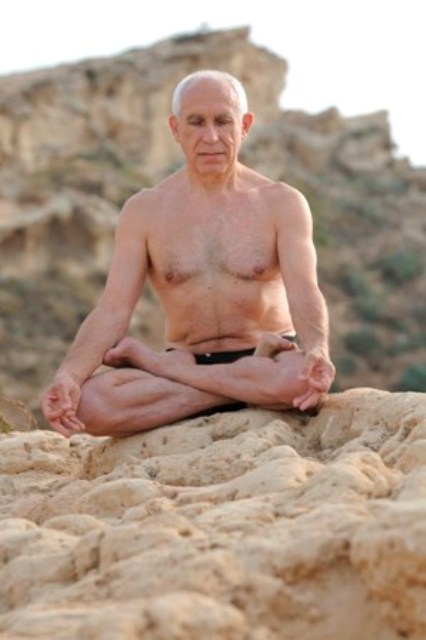
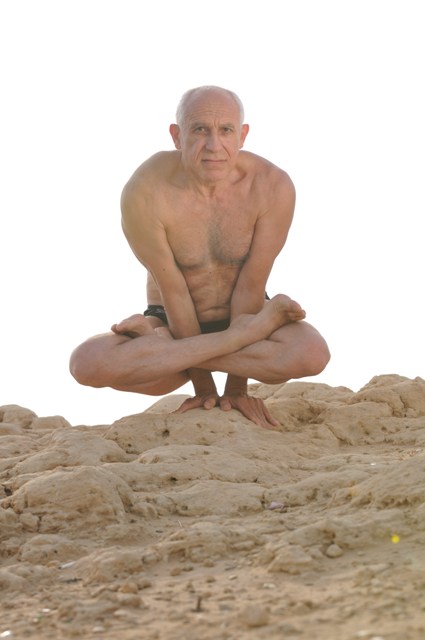
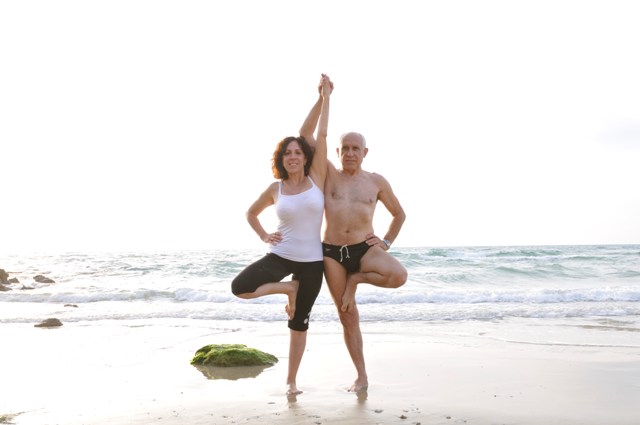
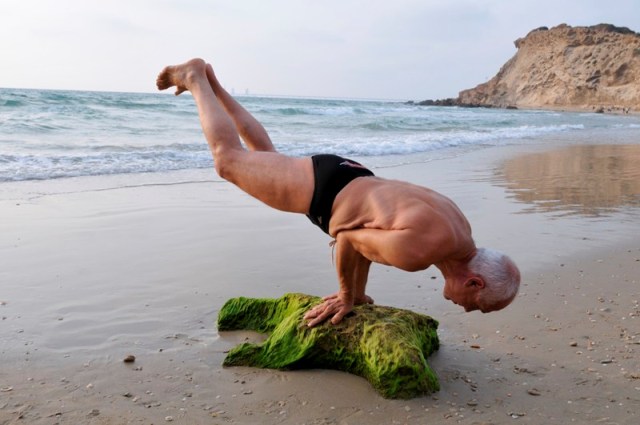
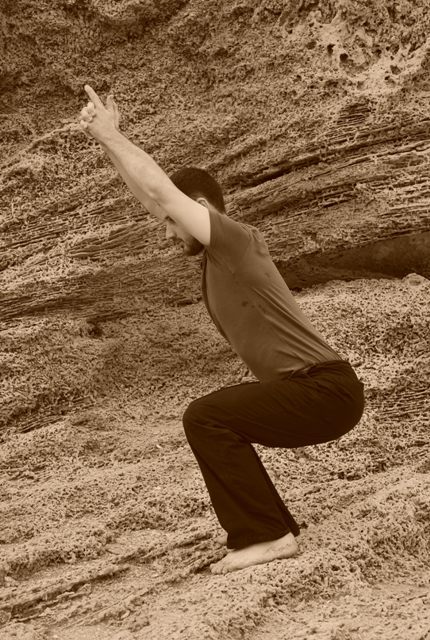
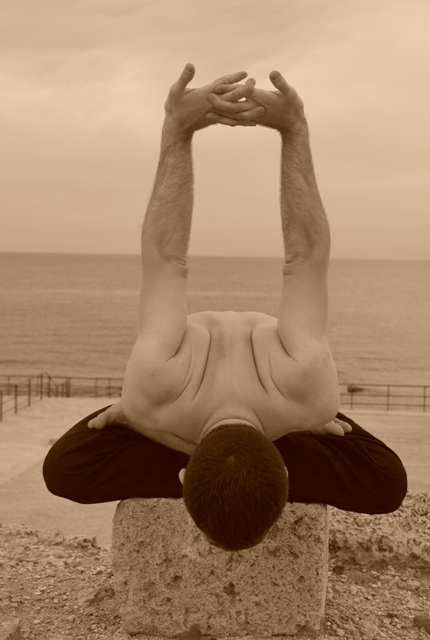
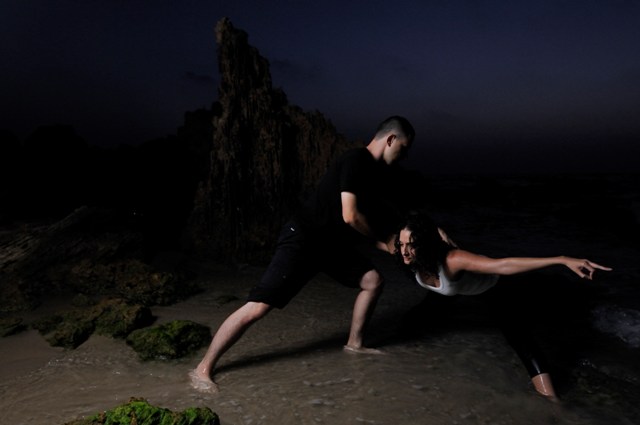
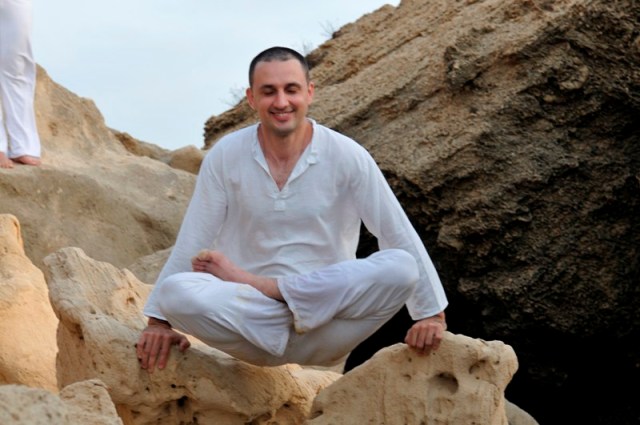
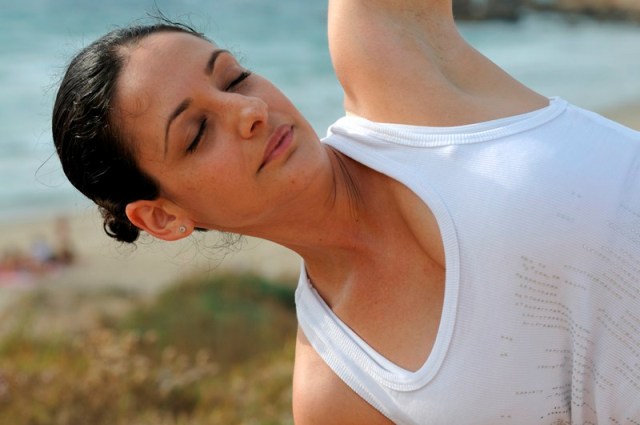
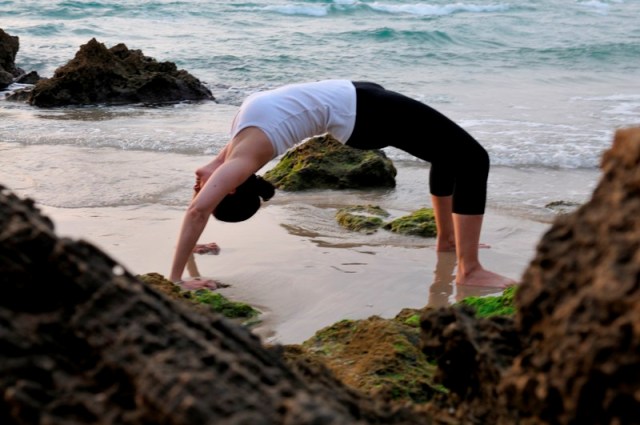
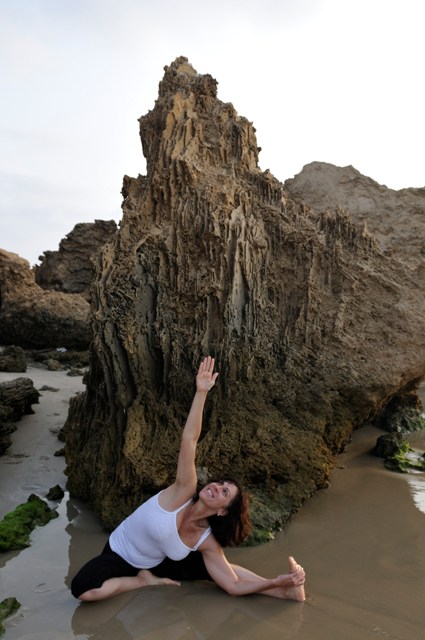


 סדנת השיאצו היא חוג כייפי מאד.
סדנת השיאצו היא חוג כייפי מאד.